NASA Images Show Epic "Marsquakes" That Kicked Out Blocks of Ice
The event exposed ice that had been buried beneath the planet's surface.
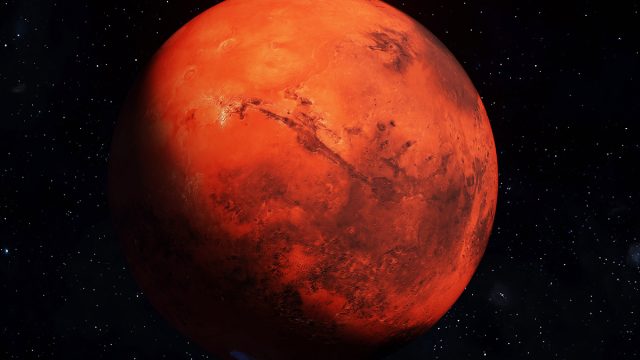
Late last year, NASA's robot InSight Lander detected a quake on Mars, or Marsquake, but they only recently determined what caused it. The temblor was significant—magnitude 4—and so was the source: A meteor strike. In addition to the quake, the impact caused a crater to form that's 490 feet wide and 70 feet deep.
The meteorite may have been 16 to 39 feet wide, and the collision threw debris up to 23 miles away. It's not the biggest crater to form on Mars, but it's the largest since exploratory missions to the Red Planet began, NASA reported in the Oct. 27 issue of the journal Science. It also exposed ice that had been buried beneath the planet's surface.
The discovery by the InSight Lander is one of its last. Since landing on the surface of Mars in 2018, the craft has detected 1,318 Marsquakes. It's scheduled to shut down in six weeks. Read on to find out more about this latest Marsquake and what it means for the future of Mars exploration.
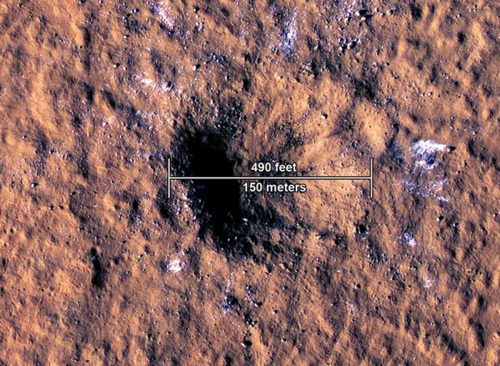
Scientists at Malin Space Science Systems (MSSS) first spotted the crater on February 11, when they were taking photographs of the area. "When that image came back, it was so unusual, like we've never seen before," Liliya Posiolova, of the facility's Orbital Science and Operations Group told USA Today.
"This dust disturbance area was so large. … We've kind of been calling it a Guinness record." A look through a color camera revealed debris, and ultimately the largest seismic event detected on the planet in 16 years. "We're very lucky," said Posiolova. "The fact that InSight's mission was operating during that time and was able to record this, that makes it that much more special."
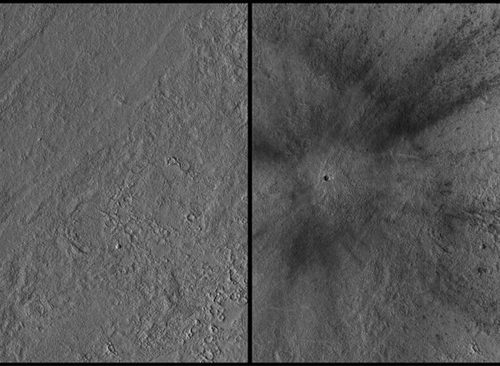
According to NASA's Jet Propulsion Laboratory (JPL), the meteor was so small that it would have burned up when it reached Earth's atmosphere. But the atmosphere on Mars is much thinner—only 1% as dense as Earth's—so the asteroid was able to strike the surface and cause significant effects.
"The image of the impact was unlike any I had seen before, with the massive crater, the exposed ice, and the dramatic blast zone preserved in the Martian dust," said Posiolova in a statement. "I couldn't help but imagine what it must have been like to witness the impact, the atmospheric blast, and debris ejected miles downrange."

InSight also captured images of buried chunks of ice that had been exposed in a novel location. "The meteoroid excavated boulder-size chunks of ice buried closer to the Martian equator than ever found before—a discovery with implications for NASA's future plans to send astronauts to the Red Planet," NASA said in a news release last Thursday.
The ice might be utilized by future Mars explorers for drinking water, agriculture and rocket propellant. "Impact events are extremely helpful in seismology," said Andrea Rajšić, a doctoral candidate at Curtin University in Australia and co-author of the Science paper. "This is a fantastic way to peek into the interior structure of the Red Planet."
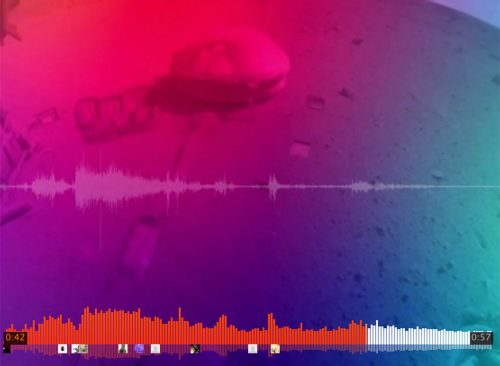
You can also hear what the impact sounded like. On Thursday, NASA posted a file to Soundcloud that's a seismogram and sonification of the signals the InSight Lander recorded. InSight's seismometer records signals that aren't perceptible by the human ear. To make the signals audible, scientists sped up the data 100 times. "Our @NASAInSight Mars lander 'heard' seismic signals while our Mars Reconnaissance Orbiter captured images of the impact crater made by this Martian meteorite," the agency tweeted. The file captures constantly rushing air interrupted by a distant boom.
RELATED: The 10 Most "OMG" Science Discoveries of 2022
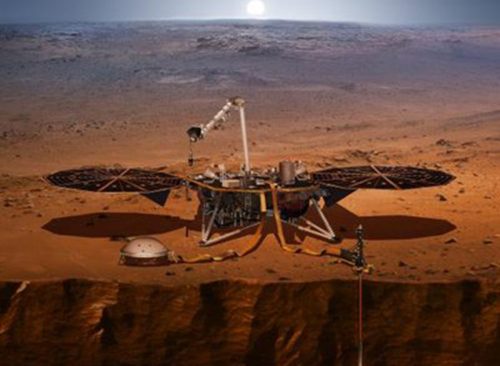
Just as it recorded the major discovery, InSight is winding down. The craft landed on Mars in 2018 and was scheduled to end its mission in 2020; NASA extended it for two more years. Dust on the surface of Mars has made it impossible for the craft's solar panels to recharge. It's a fate that's inevitable for any rover that lands on the planet. Last May, InSight took what was expected to be its final selfie. NASA posted it, along with the first selfie taken in 2018, so viewers could see the contrast between the two—a crisp image of the high-tech craft was almost entirely subsumed by planetary dust.
A dusty self-portrait.@NASAInSight took what is likely to be its final selfie on April 24. In the GIF, you can see the spacecraft's first selfie in December 2018 and its last one where it's covered in Martian dust. https://t.co/gvCNyRPnzC pic.twitter.com/CcN2Qzg90d
— NASA JPL (@NASAJPL) May 24, 2022














